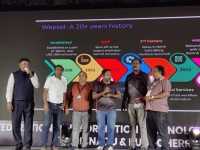### **CONFED-ITA Summit 2025 – Sponsorship Invitation** 📅 **Date:** February 21-23, 2025 📍 **Venue:** Four Points by Sheraton, Mahabalipuram Join **750+ IT hardware dealers, vendors, and industry leaders** at the **CONFED-ITA Summit 2025** – a premier platform for networking, knowledge-sharing, and business growth. ### **Event Highlights:** ✅ **Tech Showcases & Live Demos** ✅ **Breakout Sessions & Fireside Chats** ✅ **B2B Networking & Partner Training** ✅ **Workshops, Competitions & Certifications** ✅ **Gala Dinner & Entertainment**

Kuala Lumpur Getaway: 4 Days of Exploration & Leisure **Duration: 3 Nights & 4 Days** ### **Day 1: Arrival & Welcome in Kuala Lumpur** - Arrive at Kuala Lumpur International Airport & transfer to your hotel. - Enroute morning breakfast at an Indian restaurant followed by a **Putrajaya Tour**. - Lunch at an Indian restaurant. - Check-in at **Ancasa Spa Hotel** and enjoy leisure time. - Evening transfer to the venue for a **Conference (2 hrs)** followed by a **Gala Dinner with DJ** at a selected Indian restaurant. - **Overnight stay in Kuala Lumpur.** ### **Day 2: Full-Day Excursion - Genting Highlands & Batu Caves** - Buffet breakfast at the hotel. - Proceed for a **Genting Highlands full-day tour**, including a visit to **Batu Caves** and **2-way Genting Cable Car ride**. - Lunch at **Coffee Terrace Restaurant, Genting**. - Evening return to Kuala Lumpur and visit **Kuala Lumpur Tower (Observation Deck)**. - Dinner at an Indian restaurant. - **Overnight stay in Kuala Lumpur.** ### **Day 3: Free Day for Leisure & Exploration** - Buffet breakfast at the hotel. - Enjoy a **free day** to explore Kuala Lumpur at your own pace. - **Overnight stay in Kuala Lumpur.** ### **Day 4: Kuala Lumpur City Tour & Departure** - Buffet breakfast at the hotel. - 10:00 AM: Check out and proceed for a **Kuala Lumpur City Tour**. - Lunch followed by **continued sightseeing** before heading to the airport. - Transfer to Kuala Lumpur International Airport for your return flight.


